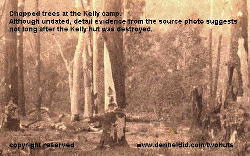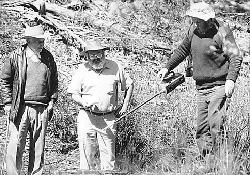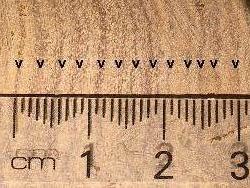www.denheldid.com/twohuts/treefragments.htm
This page sets out to provide some 'provenance' that helps establishes authentication for the Kelly target tree wood fragments. From an area then known as Bullock Ck - Kelly camp. Here the Kellys were living in hiding for 6 months.
Many trees around their camp had been used for target practice. We cannot prove this tree trunk wood was a target tree and shot at by the Kellys but all historic evidence points to this being the case. It is the last target tree to survive the ravages of time.
I can verify that following a line of ' provenance' - such as first hand knowledge passed down to me and many others - by highly respected Kelly historian Mr. Bill Stewart of Mansfield (now deceased), that this log at Kellys camp was visited by him and his father as early as 1909. There are Parish plans only recently discovered by Sheila Hutchinson and Fay Johnson in the Public archives that show a Kelly target tree as a boundary marker. At the time the DSE work party salvaged the log Jan 2004, (at my initiation with support of Friends of Ned,) the DSE informed me that some of the rotten part of the log broke away during lifting out of the bog. The wood offered here as ' keepsake' is from a portion left behind - half buried in the creek to rot away.
Apart from the first 1883 image of the Kelly camp target tree below, all other images relate to the same target tree.
Images below. - private collections, courtesy of C. Engelke, S. Hutchinson and MHS. Copy right reserved.
 |
|
 |
Target trees Kelly Camp circa 1883 - Kelly Ck target tree 1930 - Bill Stewart, John Lahey and Allan McMillon 1985
|
|
|
|
DSE historian and myself at the remains of target tree log 2004. Friends of Ned at the reclaimed log site .
|
|
|
|
This is the same piece as circled
above. -
A few slices were sawn off the end. - Apart from a few slices shown here, all the
lose fragments are shown below.
The saw cuts across the
grain help identification of the wood. The target tree was recorded as
Peppermint Gum.
Little information can be found except- ( Peppermint - Eucalyptus
dives, "Broad-leaved peppermint ) described - in general terms- has a rough
grey brown bark at the bottom with a smoother upper trunk and branches. The
name,
Peppermint derives from the aroma given off from the leaves when crushed. Also
Eucalyptus Regnans or Mountain Ash.
The tree trunk stood without branches for many years at the sawmill site till it came down after
1930's and was assumedly cut up for firewood. At one end of the big log
there are 'chainsaw' marks indicating recent times (1950's) when
the giant tree log was cut up. The wood cutters only left the rotten butt end
that ended up in the creek bog below.
 On having seen the log in 1985,
and then recovered it in 2004, I estimate it was at least 1.2 meter in Dia. A cross section
of the fragment reveals growth rings about 2.5 mm apart. A rough calculation suggests the tree to have lived for
up to 240 years. However as we do not have a full set of rings we should assume
that early growth was speedy and the latter growth was very slow. A conservative
estimate of age could be set at 200 years.
On having seen the log in 1985,
and then recovered it in 2004, I estimate it was at least 1.2 meter in Dia. A cross section
of the fragment reveals growth rings about 2.5 mm apart. A rough calculation suggests the tree to have lived for
up to 240 years. However as we do not have a full set of rings we should assume
that early growth was speedy and the latter growth was very slow. A conservative
estimate of age could be set at 200 years.
A slice off the end
of our small fragment reveals fine growth rings as dotted.
The smell of the wood is still leathery fresh.
The 200 year old tree by the1930ís was already dead but left standing
upright.
The tree was 150 years old when the Kellys used it for target practice. It was
50 years old when Captain Cook came by to claim Australia 1776.
Bill Denheld
What do you think, have an
opinion about the stories contained in Iron icon website ?
Email me your thoughts and claim a piece of true Kelly
target tree and history.
Contact
Feedback
Many pieces have already been assigned.